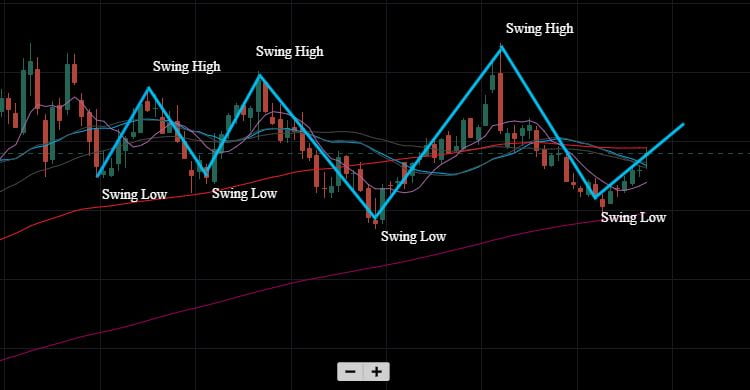Image Source: Canva
Table of Contents
If you’re new to the whole trading scene and want easy guide on how to get started with swing trading, I’ve got you covered: after tackling swing trading for 5 years, I’ve really enjoyed deep and built a solid base of knowledge: below, you’ll find a step-by-step guide that tells you all you need to wrap your head around swing trading.
Introduction-Swing Trading
Swing trading is essentially a way to trade in the stock market where, you try to make a money on the times when stock prices change a bit over a few days or weeks as part of a bigger up and down pattern, or “swing.” Traders look to buy when prices are low and sell when they’re high (that’s going long) or do it the other significantly around (going short) based on how they think the trend is going.
You need an good combination of knowledge in technical and fundamental analysis, spotting market trends; and keeping your risks in check. And you definitely must be disciplined with yourself to make it big in swing trading.

4 Merits and Demerits of Swing Trading
Swing traders usually assess trades on a risk-reward basis. Traders mostly use technical analysis due to the short-term nature of the trades. And often analyze weekly, daily, or even hourly charts to enter the trade and place their stop-loss.
😃 Merits
- Trading requires minimal time commitment and does not require constant monitoring as the holding period is longer than that of day trading.
- Swing trading maximizes short-term profit potential and may fetch higher returns than day trading. On average, an individual can make 10–50% per annum from swing trading.
- Traders mainly depend on technical analysis, which makes the trading very simple to understand. It is less stressful when compared to day trading.
- Trading can be done part-time and can be combined with a 9 to 5 job or any other business to constantly generate cash flow.
🥵 Demerits
- This trading style includes being subject to overnight and weekend market risk, such as significant price gaps due to unforeseen events and news.
- Swing traders usually miss the very long-term trends in favor of short-term swings, which last for a few days or weeks only.
- Trading costs can easily add up to a huge amount when compared to long-term investing, where one trade lasts for many months or years.
- The possibility of missing great stocks is high since swing trades are for a short time period and would fetch more money if held for long-term investing. Examples of such stocks include Microsoft,Alphabet, Tesla,Amazon, Apple, etc.
"Winning the Swing: Is Swing Trading profitable?"
This style of trading can be profitable for some individuals, but success is not guaranteed. It involves holding and maintaining positions for a few days to weeks, capitalizing on short- to medium-term market moves (swings) within a larger trend. Profits can come from market fluctuations within this timeframe. However, it requires the individuals to be skilled in technical analysis, risk management, and in-depth market understanding. Traders should understand that not every swing trade will be profitable, and there will be some losses. The people who do make money with trading are the ones who ditch their losses quick and then hang onto the ones that are winning for as long as they can; this way, they keep their losses small and let their profits become a lot bigger.
If a trader wants to stay successful, they need to have a good master plan for trading, stay disciplined, know their limits with risks, and be ready to reconfigure things when the market shifts.
"Navigating the Risks: Is Swing Trading good for beginners?"
Yes! Swing trading can be a pretty good starting point for newbies, provided they keep a few things in mind: because it operates over a more extended period than day trading, it allows people who are new to figure out what’s happening in the stock market without needing to make extremely fast, high-pressure choices.
Here’s how it could be beneficial:
Easier Learning Process: Swing trading isn’t as tricky to learn as day trading; it allows beginners to take their time to get to know how the markets move and learn about different charts and signals without having to make lightning-fast trades to stay afloat.
- Less time-intensive: It fits well for most people who’ve got daily jobs or other things to do. Keeping an eye on how stocks are doing a couple of times each day can still lead to success without needing to watch it at its most basic level.
- Reduced Stress: The reduced frequency of swing trades compared to day trading can be calmer for beginners who might feel overwhelmed by quick market movements.
However, there are conditions:
- Market Understanding: Beginners must still grasp market fundamentals, technical analysis, and risk management. It’s very crucial to understand the chosen asset class and the factors that affect their prices.
- Patience and Discipline: You need to wait patiently sometimes to wait for the perfect trading chance, really stick to your set approach plan (where you decide when to join in or get out), and keep up with an informed plan to deal with risky trades.
- Risk Management: Beginners must learn to manage risk effectively; they must focus on setting stop-loss orders and making sure they don’t throw in more money than they can handle losing in a single trade.
- Education: While swing trading can be a good starting point for beginners due to its slightly relaxed pace, it’s very essential to combine it with correct education, a lot of practice, and a very cautious approach to managing risk.
"Master the Art of Profit: 5 Proven Ways to Find Breakout Stocks"
A stock that breaks its support or resistance level is considered a breakout stock. These support and resistance levels represent the areas where the stock has struggled to cross over during a specific time period. Breakouts are often seen as a strong indicator that the stock is likely to move in an upward or downward direction.However, to spot a potential stock, a combination of intuition and research is also necessary.
Here are 5 proven ways to identify breakout stocks.
- Monitor for key market trends: Swing traders should keep an eye on market trends. One can analyze the index’s (Nifty 50, Bank nifty, etc.) to get an idea of overall market trends. By analyzing market trends, individuals can identify specific sectors that may give breakout stocks in the near future.
- Watch for volume and price: Individuals can look for breakout stocks by looking for stocks with increasing volume and momentum in price. Breakout stocks usually have a sudden rise in volume in trades, which signals the growing interest in the traders. Also, individuals should keep an eye out for stocks that are crossing through key support or resistance levels and forming bullish patterns in the chart, for example, cup-and-handle, ascending triangles, or flag patterns
- Keep an eye for stock’s momentum and relative strength: The relative strength index (RSI) is the most commonly used technical indicator for analyzing the strength of a stock relative to its peers. And the stochastic momentum index (SMI) is also one of the best indicators that measures the momentum of a stock’s price. These two indicators are among the best indicators to identify an overbought or oversold zone in a particular stock price and helps to identify a potential breakout.
- Tracking companies with strong fundamentals: To find the breakout stocks, individuals should look for companies with strong fundamentals, like growing profits, increasing revenue, and a positive cash flow. These data suggest that the company is doing good financially, and these company stocks are more likely to break out in price. Individuals can find these data in the quarterly earnings results.
- Keep an eye out for catalysts: Catalysts are the most recent changes or developments that could drive stock prices upward or downward. For example, new product launches, merging or taking over small companies, or some good news from the government or reserve banks.
Conclusion
Swing trading is, in essence, a favorite for several traders, and it’s a good way to trade the market. Your mission, if you go for it, is to catch the swings of a longer trend. Remember, swing trading is essentially speculative, and you must be informed of how much you’re willing to risk. You should have limits set so you’re not losing big money, and always use stop-loss when trading. Swing trading can be a good starting point for newbies to the world of stocks.
FAQ's for Swing Trading
No! The market operates every day except on weekends and public holidays. Please check the holiday list provided by the NSE exchange.
Individuals can use online stock screeners such as TradingView, etc., or financial portals such as MoneyControl, etc., that provide insight on a company’s fundamentals, valuation, market cap, and a lot more.
Some of the best indicators for swing trading for accuracy are listed below.
- MA-21 Day Moving Average.
- RSI (Relative Strength Index).
- SMI (Stochastic Momentum Index).
- CCI (Commodity Channel Index).
- Bollinger Bands.
There is no perfect rule for the minimum amount of money required for swing trading. An individual, as a beginner, can start with Rs. 5,000, 50,000, or 2,00,000, depending on their budget. Although it is advisable to use around 10% to 15% of your overall capital, once you become an expert, you can go up to 30% to 50%.
But if you really have a very low margin and really want to start trading, then you can also opt for the MTF facility provided by some of the leading brokers in India, such as Upstox, Dhan, Rupeezy, Angle One, 5 Paise, etc.
Some of the most successful Swing Traders are Mark Minervini,George Soros,Andy Krieger,Nicolas Darvas,Paul Tudor.
Disclaimer: This article about Business, finance and investments contains material solely for educational purposes. It does not constitute investment advice. While we try to be accurate, we cannot guarantee that the information is appropriate or full. It is recommended that readers get advice from a licensed financial expert prior to making any investing decisions.
Video Tutorial for Swing Trading-English
Learn more about swing trading from one of the popular YouTubers, Jake Broe.
Video Tutorial for Swing Trading-Hindi
Are you new to swing trading and want to learn more? There’s nowhere else to look! We have discussed swing trading methods and beginner-friendly backtesting in this video. Prepare yourself to step up your trading game now.
Related Posts

TATA Upcoming IPO 2024 | Get Ready to Apply Soon!
(Image Source: Canva) Table of Contents Want to invest in Tata Group

IREDA Share Price | Analysis & Targets 2024-2030
(Image Source: Canva) Table of Contents “Curious about IREDA’s stock performance? Discover

Porinju Veliyath-Investor | Investing Brilliance Decoded
Table of Contents “Wondering how Porinju Veliyath achieves investing brilliance? What are

Ashish Kacholia-Investor | Visionary Approach, Solid Returns.
Table of Contents “Who is Ashish Kacholia? Discover the secrets behind his

Zerodha vs Upstox | Find out how Zerodha stacks up against Upstox
(Image Source: Canva) Table of Contents Are you worried and curious about

Investing in Silver | 5 Popular Ways to Invest in Silver!
(Image Source: Canva) Table of Contents Curious about how to start investing
